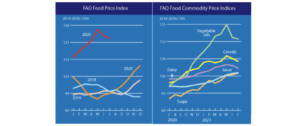Congress has quickly engaged in putting together potential aid packages for farmers that would more than double the Trump administration's $12 billion under the Farmer Bridge Assistance (FBA) Program.
World Food Prices Fall in July, as the Supply Outlook for Grain Tightens in Some Regions
Reuters News reported today that, “World food prices eased for a second month in a row in July, reflecting declines for cereals, vegetable oils and dairy products, but remained up nearly a third over the past year, the United Nations food agency said on Thursday.
“The Food and Agriculture Organization’s (FAO) food price index, which tracks international prices of the most globally traded food commodities, averaged 123.0 points last month compared with 124.6 in June.
“On a year-on-year basis, prices were up 31.0% in July.”

The Reuters article noted that, “The Rome-based FAO’s index had declined in June for the first time in a year, marking a pause in a broad rally in agricultural commodities fuelled by harvest setbacks and Chinese-fuelled demand.
“FAO’s cereal price index fell 3.0% in July from the previous month, weighed down by a 6% drop in maize (corn) prices.”
.@BloombergTV Video: Global #Food Prices Fall in Sign of Relief for Consumers, interview w @megandurisin https://t.co/TZzHmaztWz
— Farm Policy (@FarmPolicy) August 5, 2021
Meanwhile, Reuters writers Rod Nickel and Karl Plume reported on Thursday that, “Millers and bakers are draining wheat reserves and paying more for spring wheat used in baking, as drought shrivels crops across the Canadian Prairies and northern U.S. Plains that produce more than half of the world’s supply.
“U.S. and Canadian farmers are bracing for a sharply smaller spring wheat harvest due to the driest conditions in decades, as severe weather damages crops across the hemisphere, from heat scorching cherries in the U.S. Pacific Northwest to frost chilling sugarcane in Brazil.
Approximately 99% of spring #wheat production is within an area experiencing #drought, @usda_oce pic.twitter.com/XpFtephyBt
— Farm Policy (@FarmPolicy) August 5, 2021
“While overall global wheat stocks are large, the drought affects mainly the high-protein spring wheat crop that millers such as Archer Daniels Midland Co and bakers including Grupo Bimbo rely on to produce the texture and moistness in baked goods that consumers expect.”
Nickel and Plume explained that, “The U.S. spring wheat harvest is expected to drop 41% from a year ago to the lowest production in 33 years, according to the U.S. Department of Agriculture (USDA).
“The USDA on Monday estimated that just 10% of the country’s spring wheat crop was in good or excellent condition, down from 73% a year ago and the lowest rating for this point of the season since the 1988 drought.”
2021 has by far the worst-rated U.S. spring wheat crop since 1988.
— NIDIS Drought.gov (@DroughtGov) July 27, 2021
Only 2002, 2006, and 2017 come close. And spring wheat conditions have continued to decline.#drought @USDA @usda_nass pic.twitter.com/d8HBjtsTpN
In related news, Bloomberg writer Megan Durisin reported earlier this week that, “Major crop buyers across Africa and Asia are pulling back from purchases, highlighting how the price rally across grain and oilseed markets is curbing demand.
“Top wheat importer Egypt booked a lone grain cargo at a tender on Monday, its smallest volume in nearly a year, and has now scrapped a vegetable oils tender. Turkey canceled a tender seeking 515,000 tons of feed barley, a rare move. Jordan did the same for wheat, and Pakistan bought less than half the amount it sought last week.
The moves come as supply outlooks tighten across major wheat producers, with heat, drought and floods combining to chip away at production estimates. That’s boosting global prices at a time of year when importers typically count on a flurry of freshly harvested grain to help keep purchases affordable. Vegetable oil prices are also elevated as biodiesel demand climbs.
In other news regarding global grain supply, Reuters writer Ana Mano reported earlier this week that, “Unfavorable weather caused second corn yields in the center-south of Brazil to plunge to their lowest level in 10 years, agribusiness consultancy AgRural said on Monday, projecting productivity at 66.6 60-kilo bags per hectare.
“After drought then frosts spoiled much of the crop, Brazilian farmers are now expected to collect 51.6 million tonnes of second corn, almost 19 million tonnes below the 70.5 million from last season, AgRural said.”
And a related Reuters article this week pointed out that, “Brazilian corn exports are expected to plunge in August to around 3 million tonnes, according to ship line-up data from maritime agency Cargonave and projections by grain exporters association Anec on Tuesday. Shipping schedules showed corn exports at 6.7 million tonnes in August of 2020, data from Cargonave showed. Anec said corn shipments this August would be at best only as high as 4 million tonnes amid severe crop failure.
“Brazil’s second corn crop, badly affected by drought and an ill-timed frost starting in June, will be a lot smaller than initially forecast this year, hurting export prospects.”





